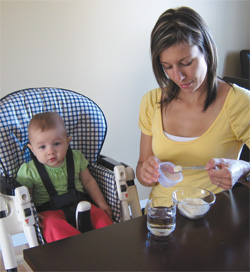Grain products

![]() Iron-enriched baby cereals are among the first foods you should introduce to your baby.
Iron-enriched baby cereals are among the first foods you should introduce to your baby.
Photo: Pascale Turcotte
This food group includes grains like oats, wheat, barley, rice, buckwheat, rye, millet, and quinoa. It also includes pasta and bread.
Iron-enriched cereals
Iron-enriched baby cereals not only contain iron, but other vitamins and minerals as well. They are among the first foods that should be introduced.
How to choose cereal
Start by giving cereals containing only one type of grain (e.g., barley).
At the beginning, opt for cereals containing no fruit, vegetables, or other additions.
Choose sugar-free cereals. Carefully read the ingredients list on the packaging. Sugar hides behind many names, including dextrose, maltose, sucrose, inverted sugar, glucose polymers, fructose, syrup, and honey.
As time goes on, you can add fruit to baby cereals or buy a variety of cereal mixes.
How to prepare cereal
To prepare cereal, use breast milk or infant formula. Some cereals already contain powdered milk, in which case all you have to do is add water.
It’s important not to add sugar to cereal.
Serving cereal or any other food in a baby bottle is not recommended.
Other grain products
Once your baby is eating iron-rich foods at least twice a day and has a varied diet, you can introduce other grain products.
It’s best to opt for whole grain products like whole wheat bread and pasta. They contain more fibre, which ensures your baby has regular bowel movements. To help you choose, read the list of ingredients: the first ingredient must be a whole grain (e.g., whole grain oats or whole wheat flour).
If your baby accepts different textures, offer her foods like toast, pita bread, naan bread or chapati, tortillas, breadsticks, unsalted crackers, unsweetened oat ring cereal, and all types of pasta.
Be careful with rice because your child can choke on it. It’s best to start with sticky, short-grain rice and mash it with a fork.


